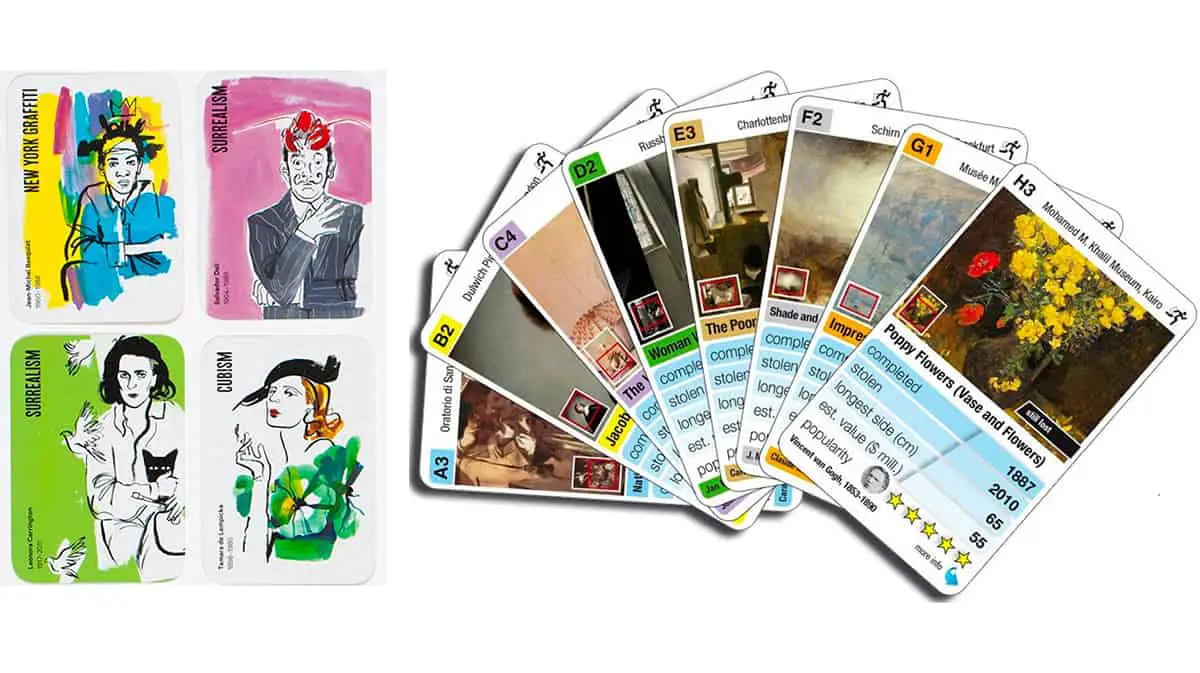This post contains affiliate links.
Sylvie de Soye showed me how effective card games can be to create interest in art history in children. This inspired me to make a list of them for you (and selfishly for myself as well!).
showed me how effective card games can be to create interest in art history in children. This inspired me to make a list of them for you (and selfishly for myself as well!).
Art history card games can be divided in:
- Games about famous paintings using:
- Matching rules (memory, old maid) like Close Up Art, Modern Art Memory Game and Ditto American Art.
- Family-based rules (Go Fish, Happy Family) like Birdcage Press’s Go Fish Art Games (4 different games)
- Modern rules like the original and clever Famous Art Robberies
- Games about famous artists and movements: Clash of the Titians allows “War” play while Manifesto! is a Family game, My Big Art Show a Rummy game, Art Snap a simple matching game and Van Gogh card game is a Family game.
- Art history knowledge-based games: Art by Brainbox is a very accessible game based on memorizing facts and details of paintings, while History of Art by Professor Noggin is a trivia game that requires deep art history knowledge (best suited for school).
If you are more interested in other types of history games, you can jump straight here.
Now let’s dive into more detail about each of these games. I am sure that you are impatient to know more about them!
5 Card Games About Famous Paintings
Art History Matching Games
Close Up Art Card Game MoMA (Birdcage Press)

This game can not only be played as a memory like “modern Art Memory Game” by AMMO, but also as “Old Maid” (much better for older children), and with two other matching rules. The reason for that is that the cards are regular “vertical” sized cards (not square cards) and thus can be easily held in one’s hand.
can not only be played as a memory like “modern Art Memory Game” by AMMO, but also as “Old Maid” (much better for older children), and with two other matching rules. The reason for that is that the cards are regular “vertical” sized cards (not square cards) and thus can be easily held in one’s hand.
The game features 48 playing cards (24 works of art) from the Museum of Modern Art (MoMA). The cards are well designed, and intelligently the cards to pair are different:
- The first card features the painting with the name of the artist, the name of the painting and the date it was made.
- The second card features the painting on the full size of the card
So I highly recommend this game which is both cheap and well designed.
Birdcage Press also had a “Close Up” made with artworks from the Museum of Fine Arts of Boston, but this game is now unfortunately out of print and seemingly discontinued.
Modern Art Memory Game (AMMO)
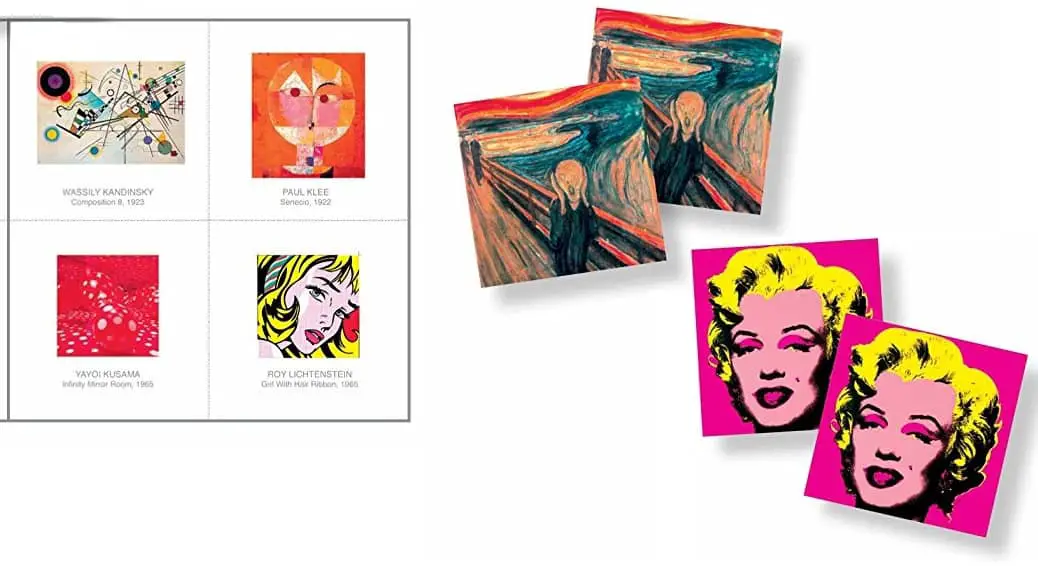
The “Modern Art Memory Game ” has 72 cards, featuring 36 paintings (twice each as it is a memory game) from 36 famous artists like Warhol, Munch, Matisse, Picasso, van Gogh, Kandinsky and more.
” has 72 cards, featuring 36 paintings (twice each as it is a memory game) from 36 famous artists like Warhol, Munch, Matisse, Picasso, van Gogh, Kandinsky and more.
There is also a booklet with the name of the artist, the piece, and the year it was created. As the game of memory is for really small children, another rule is proposed based on earning points for remembering facts behind each artwork.
I recommend this memory game for families with small children (Kindergarten or Preschool) as it is not too expensive and the quality of the cards is good.
But there is a real missed opportunity to make a game that could also be interesting from a teacher’s point of view by beefing up the information in the booklet concerning each painting. It would have been so much better to have more facts there to make the second rule more worthwhile.
Another disappointing thing is that the works of art are not numbered, making them more difficult to find in the booklet.
Ditto American Art (Birdcage Press)

Ditto American Art is a classic memory game, just like Modern Art Memory Game by AMMO. It has 48 art tiles (24 works of art) and 8 large cards. So this game is nice for Preschool of Kindergarten (3 to 5 year-olds).
is a classic memory game, just like Modern Art Memory Game by AMMO. It has 48 art tiles (24 works of art) and 8 large cards. So this game is nice for Preschool of Kindergarten (3 to 5 year-olds).
An interesting thing is that it is the only game in the ones that I list here that focuses on American Art.
“Go Fish” Art Games (Birdcage Press)
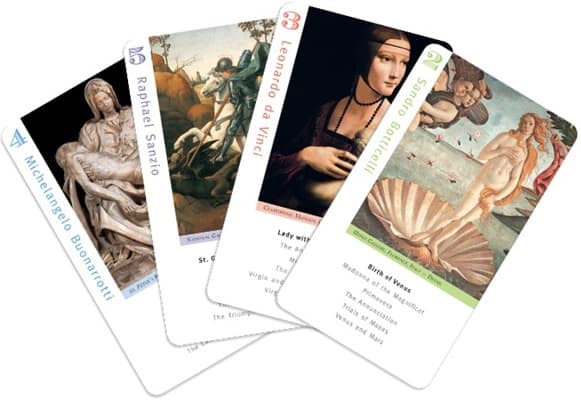
These games are very reasonably priced and well made. I highly recommend them. Each of them features:
- 36 cards, each of them with a different work of art (if only there would be more cards per game!)
- A 30+ page booklet that gives well designed out and interesting information about the artists and the art movements involved.
Game cards are organized into several families (so as to be able to play Go Fish or Happy Families), one for each artist, art movement or art information.
Note: this is not your standard "Go Fish" rule. There are no sets of identical cards, but card families. You gather cards in families to win, so it is more similar to "Happy Families" than "Go Fish".
Birdgage Press has 4 such games:
- for Renaissance Artists
 with 6 families: Botticelli, Raphaël, Michelangelo, Da Vinci, Fra Angelico, “Renaissance Art is…” (Religious Subjects, Born in Italy, Inspired by Ancient Greece, Invisible Brushstrokes, Peculiar Paints, Triangle Compositions)
with 6 families: Botticelli, Raphaël, Michelangelo, Da Vinci, Fra Angelico, “Renaissance Art is…” (Religious Subjects, Born in Italy, Inspired by Ancient Greece, Invisible Brushstrokes, Peculiar Paints, Triangle Compositions) - for Impressionist Artists
 with 8 families: Degas, Renoir, Monet, Caillebotte, Cassatt, Manet, Pissarro, Morisot
with 8 families: Degas, Renoir, Monet, Caillebotte, Cassatt, Manet, Pissarro, Morisot - for Van Gogh and Friends
 with Van Gogh, Toulouse-Lautrec, Gauguin, Cezanne, Rousseau, and Seurat
with Van Gogh, Toulouse-Lautrec, Gauguin, Cezanne, Rousseau, and Seurat - for Ancient Egypt
 with mummies, afterlife, goddesses, symbols, gods, and pharaohs. This is also a great game as young children love learning about ancient Egypt.
with mummies, afterlife, goddesses, symbols, gods, and pharaohs. This is also a great game as young children love learning about ancient Egypt.
Other Game Mechanisms
Famous Art Robberies (Kulturmeister)
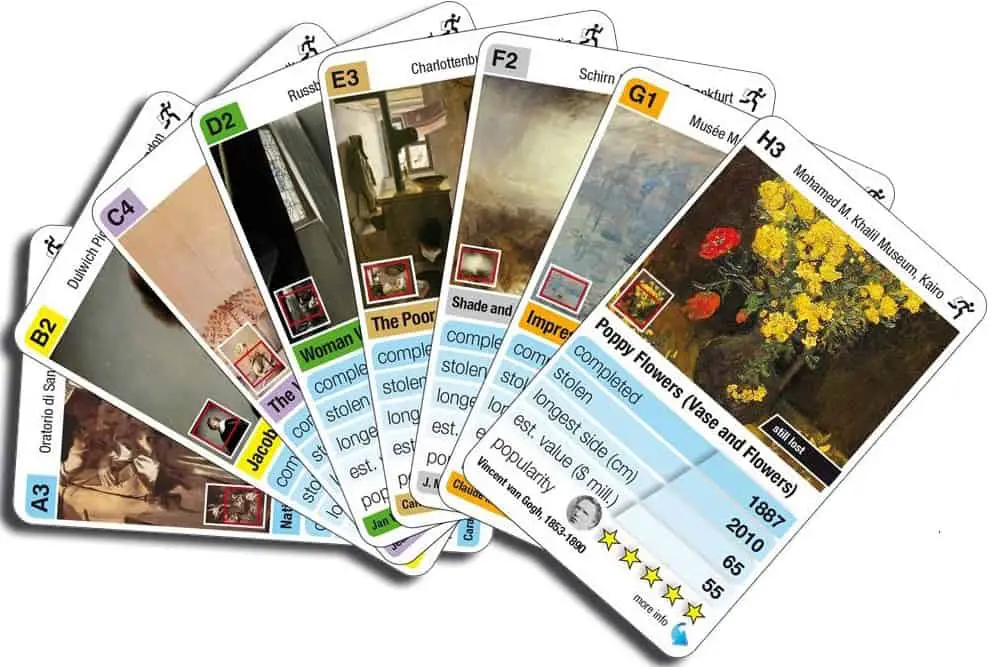
I love this “Famous Art Robberies ” game because the theme is such an original and fun way to address great paintings. It contains 32 cards, each about a famous painting that was robbed. They have the following information on their face:
” game because the theme is such an original and fun way to address great paintings. It contains 32 cards, each about a famous painting that was robbed. They have the following information on their face:
- The museum where it was stolen
- The painting itself
- When the artwork was completed and stolen
- The longest side of the artwork
- It’s value
- The Popularity of the artist
You will be shocked by the number of great art pieces that were once stolen, including artworks of da Vinci, Monet, Rembrandt, Rubens, Vermeer, Goya, van Eyck, Turner, Corot, Degas, Cézanne, Pissarro, Manet, van Gogh, Caravaggio and Velázquez.
5 Card Games About Famous Artists And Art Movements
Clash of the Titians (Laurence King Publishing)

Clash of the Titians has 32 cards featuring classic masters such as Titian, Rembrandt, Caravaggio, etc. This game allows playing war with painters using one or several of the 6 characteristics on the cards: Influence, Versatility, Innovation, Critical reception, The “beautiful” factor, Highest price (each is between 0 and 100, except the price of course).
has 32 cards featuring classic masters such as Titian, Rembrandt, Caravaggio, etc. This game allows playing war with painters using one or several of the 6 characteristics on the cards: Influence, Versatility, Innovation, Critical reception, The “beautiful” factor, Highest price (each is between 0 and 100, except the price of course).
Note: I use a personal variation of the rule that makes the game more engaging (in my experience). Each player (at his/her turn) draws the top card from his/her game and chooses one of the 6 characteristics. The other players then show their cards and compare the painters according to this characteristic. The player with the highest characteristic wins the cards.
I find that several aspects of this game are really interesting:
- Illustrations are well-chosen and beautiful.
- There is a short text (7 lines of text) about the painter that is very relevant.
- The game’s mechanism makes the players learn something about the painters.
Unfortunately, the characteristics have two problems:
- The 0 – 100 scale is unreasonably precise (0 – 5 would be better). It makes this grading look arbitrary. Using labels such as “Huge influence” rather than “Influence 78” would be even better in my opinion.
- The gradings are not justified. This also makes them seem arbitrary. It is more important for students to remember the “WHY” Monet was influential. For example, it is more relevant to know that Monet was one of the most prominent impressionist painters and even created the term “impressionism” than to know that he is rated “76” for influence (which tells us nothing about the kind of influence he had).
So overall I do recommend the game but it could be even way better!
Manifesto!: The Art Movements Game Cards (Lauren Tamaki)
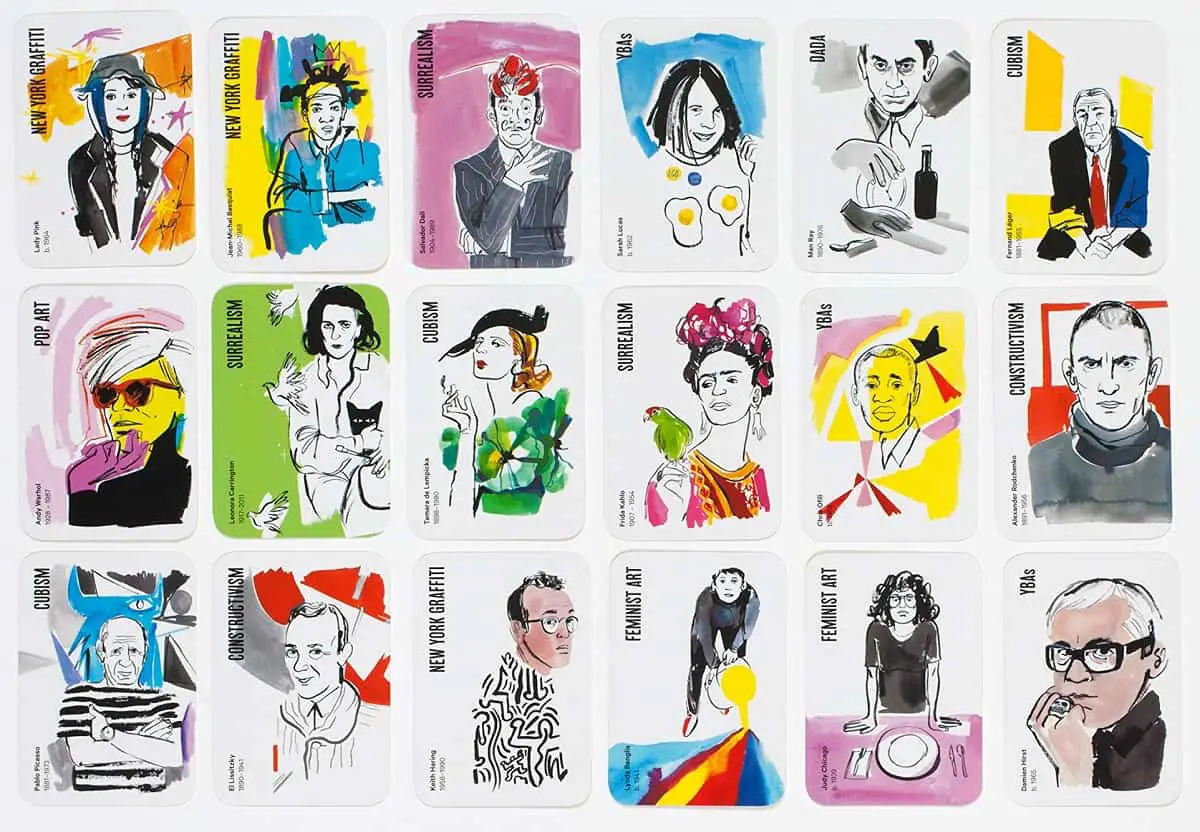
The Manifesto! game contains:
game contains:
- 52 cards, each featuring an iconic 20th-century artist. The artists are grouped into 8 art movements (Dada, Cubism, YBAs, Surrealism, New York graffiti, Pop art, Constructivism, Feminist Art).
- A booklet that relates the biographies of each artist.
Players can play “Go Fish” and “Happy Families” using these cards, the families being the art movements.
The cards are beautifully illustrated. I like the game because it teaches something about these great artists without introducing any complexity, making the game very easy to play.
My Big Art Show (Susie Hodge)
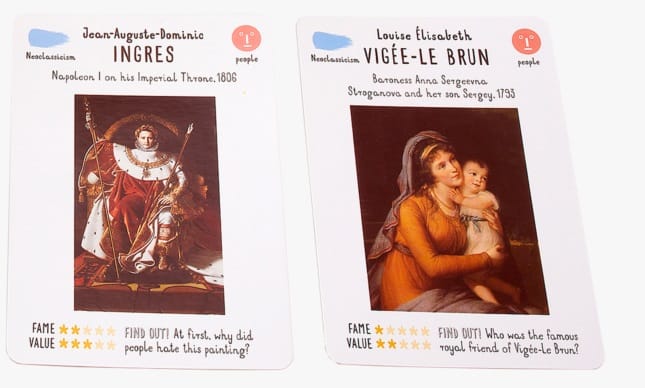
No wonder My Big Art Show is really educational and so well thought out: Susie Hodge is a well-known artist and art historian.
is really educational and so well thought out: Susie Hodge is a well-known artist and art historian.
Each of the 50 cards features a work of art and related information (artist, date, movement, theme). The movements, themes, and artists represented in the game are:
- Renaissance, Baroque, Neoclassicism, Romanticism, Realism, Impressionism, Post-Impressionism, Expressionism, Cubism, Futurism, Surrealism, and Pop Art
- People, Places, Objects, Animals, Story, and Religion
- Michelangelo, Velázquez, Degas, Van Gogh, Kandinsky, Picasso, Dalí, Warhol, Lichtenstein, Turner, etc.
This card game enables children to “build up a show” by assembling works of art that share common features. The game rule is basically the same as Rummy, and therefore very easy to use for children. As the theme and movement for each card have their respective icons, the game is easy to use even by small children (5-year-olds for instance).
There is also a complete booklet with related information and other game rules.
For all these reasons I highly recommend this game (the only thing I regret is that the cards are a bit big, but this also allows to have larger images).
Art Snap (Brainbox)
Art Snap (Brainbox) also enables to play with painters, but I do not recommend it though.
(Brainbox) also enables to play with painters, but I do not recommend it though.
This is also a matching game with 52 cards. You have to match the 26 artists with 26 paintings (2 rules: Snap and Pairs). The idea is not bad but I find the result not convincing, compared with the alternatives. Paintings are shown in small frames inside cards (a pity really), and the painter cards do not give any additional information about the painter (they just have the painter’s name on them) although there was no reason not to do it.
Van Gogh Card Game (Van Gogh Museum Amsterdam)
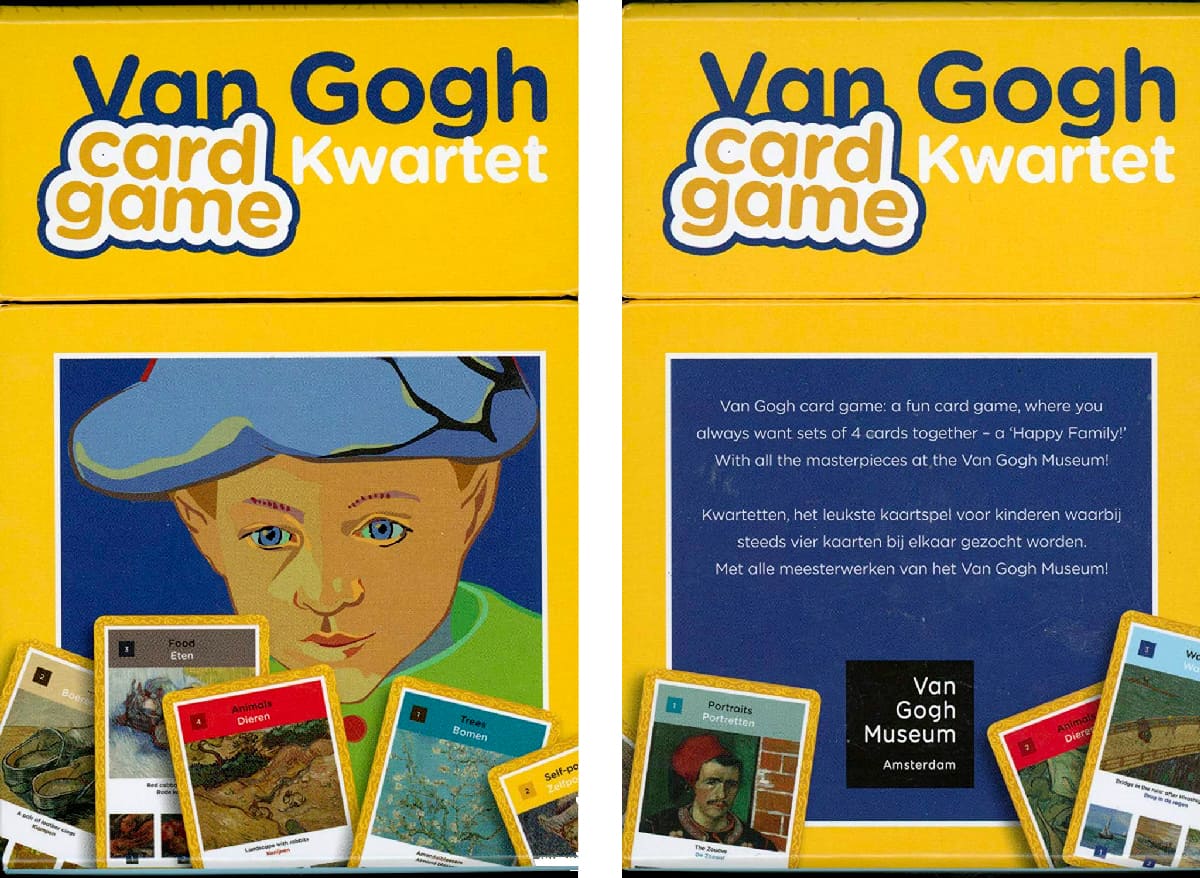
This is a “Happy Family” of Van Gogh Artworks with:
- Each 4 card family is about a specific subject: portraits, trees, animals, food, peasant life, self-portraits, water, etc.
- Large cards (about 3″x5″ cards or 8.5 x 12.5 cm), about twice larger than standard playing cards. This would enable to have rather large prints of the artworks, but instead, they are rather small as the bottom part of the card is used by small vignettes of the 3 other artworks of the same family (because of the size of the cards the game is rather expensive).
- Each card features
- The name of the family (English & Dutch)
- The reproduction of the artwork (one different Van Gogh artwork per card)
- The title of the artwork (English & Dutch)
- Vignette sized reproductions of the 3 other artworks of the same family
The artworks are from the Amsterdam Van Gogh Museum only. It is a pity that the museum did not work with other museums to propose a game with a wider choice of artworks. The most well known Van Gogh paintings can indeed be found in many different museums over the world such as MOMA (New York), Musée d’Orsay (Paris), J. Paul Getty Museum (Los Angeles), Courtauld Gallery (London), MET (New York), National Gallery (London) to name a few (even if the Amsterdam Van Gogh Museum does have great pieces).
Also, I find it regrettable that the date of the artwork is not indicated on the cards. This would have enabled to use them as a chronological game, which is a great way to teach the evolution of the style of the artist throughout his career.
Two Art History Knowledge-Based Card Games
Art (BrainBox)
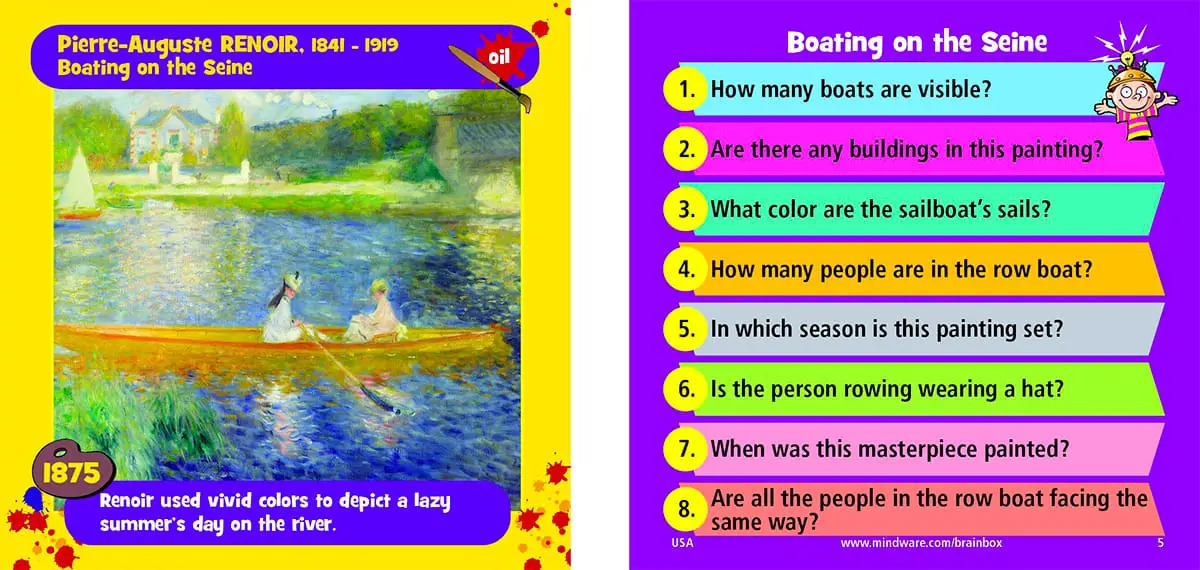
This game contains 60 cards, each featuring a masterpiece from Monet, Van Gogh, Picasso and more.
The aim of the Brainbox Art game is to win as many cards as possible. To win a card, you study it for 10 seconds, answer a question about it based on the roll of a die, and keep the card if your answer is correct.
is to win as many cards as possible. To win a card, you study it for 10 seconds, answer a question about it based on the roll of a die, and keep the card if your answer is correct.
I like the game, for several reasons:
- Players actually have to develop their observation abilities of the painting that is on the card.
- The cards have a square shape and are large enough to have rather large reproductions of the paintings, whether the artwork is vertical or horizontal.
- The face of the card (with the painting) contains some facts about the painting and the artist, which are used in the questions, so players learn about not only the contents of the painting and its context.
There are a few drawbacks that could refrain you from using this game though, although they are not too bad:
- The cards are unnecessarily thick. There are therefore only 60 cards. With such a big box (and for the same price) there could easily be 120 cards).
- Many questions are repetitive (like always asking if the painting is an oil or a watercolor), or too precise (details on the painting). The quality of the questions is uneven (some are worthwhile, others not so much).
- Printing quality is not very good (too bad for the artworks that deserve better quality).
Note that there are two versions of the game. The one made with MindWare, and the one made with the National Gallery
and the one made with the National Gallery . Both are OK.
. Both are OK.
History of Art (Professor Noggin’s)
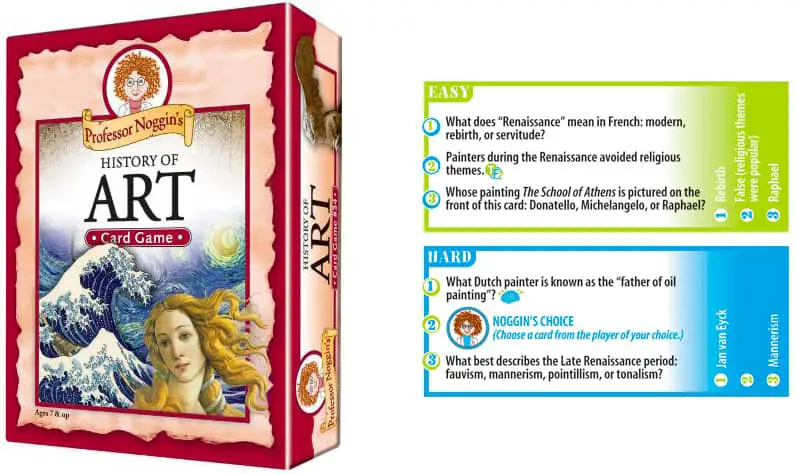
I am generally not a fan of answering random questions (quiz type games) but obviously many people appreciate those games.
Professor Noggin’s History of Art is such a game, and I recommend it! The questions are not easy to answer, but they are divided into two levels for each featured work of art.
The game is best used to revise an art history class if this class has already addressed the knowledge prerequisites in the questions. The game can be a very nice way to reinforce all that knowledge that students seem to forget so fast if it is not reused.
The game covers a lot of different topics:
- Sculpture, World Architecture, Painting Techniques and Materials
- The Renaissance, Italian Renaissance, Leonardo da Vinci, Michelangelo
- Rembrandt
- Impressionists and Post-Impressionists, Monet, Mary Cassat
- Ancient Greek, Roman, Egyptian and Byzantine Art
- Baroque, Rubens
- American Art, Canadian Art
- Modern Art, Picasso, Andy Warhol
- Art Museums: Musée du Louvre & museums of the United States
Art History Flashcards, Printables, Board Games, Playing Cards…
This list of art history card games might seem a bit long to you, but this is just the tip of the iceberg as far as art-related games are concerned!
Here is a list of other options out there that are really worth checking out:
- Art History Flashcards: Look at my post “Art History Printed Flashcard for Schools and Families“, you will find that there are some awesome decks. And in that post, I also give you a great bonus: 8 completely explained game rules to play with these Flashcards and transform them into awesome games.
- Art History Playing Cards: Read my post “18 Art History Playing Cards Games for Schools and Families” which lists 16 such games. There provide and great and cheap way to introduce children to art history while being perfectly playable with traditional games rules.
- Art History Board Games: If you are a teacher, educational art board games that really teach something about art can be great for your classroom; they have the potential to get attention from all students, even those that are not sensitive to art initially. Check my post “7 Art History Board Games for School and Home” to know more.
- Art Themed Board Games: These are “real board games” (meaning with an original and modern rule so as to suit the taste of board game “geeks”) that use an art-related theme. You might check Modern Art
 by Reiner Knizia, Fresco
by Reiner Knizia, Fresco by Marco Ruskowski and Marcel Süßelbeck, The Gallerist
by Marco Ruskowski and Marcel Süßelbeck, The Gallerist by Vital Lacerda, Kanagawa
by Vital Lacerda, Kanagawa by Bruno Cathala & Charles Chevallier, Art of Chill
by Bruno Cathala & Charles Chevallier, Art of Chill by Bob Ross or Junk Art by James Cormier
by Bob Ross or Junk Art by James Cormier and Sen-Foong Lim, etc. Just don’t expect to learn much about art playing them though (except for some of the versions of “Modern Art”), it is not their purpose!
and Sen-Foong Lim, etc. Just don’t expect to learn much about art playing them though (except for some of the versions of “Modern Art”), it is not their purpose! - Art Printables: There are so many available printables (PDFs), free or not, flashcards or not. They handle almost any subject, spanning art history in general, specific periods or genres, specific artists. I will for sure make a post about them soon!
Edudingo.com is a participant in the Amazon Services LLC Associates Program, an affiliate advertising program designed to provide a means for sites to earn advertising fees by advertising and linking to Amazon.com. We also participate in other affiliate programs which compensate us for referring traffic.

